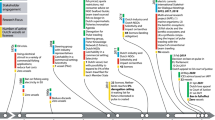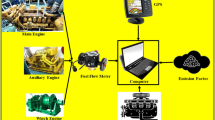Abstract
Purpose
Capture fisheries are the only industrial-scale harvesting of a wild resource for food. Temporal variability in environmental performance of fisheries has only recently begun to be explored, but only between years, not within a year. Our aim was to better understand the causes of temporal variability within and between years and to identify improvement options through management at a company level and in fisheries management.
Methods
We analyzed the variability in broad environmental impacts of a demersal freeze trawler targeting cod, haddock, saithe, and shrimp, mainly in the Norwegian Sea and in the Barents Sea. The analysis was based on daily data for fishing activities between 2011 and 2014 and the functional unit was a kilo of landing from one fishing trip. We used biological indicators in a novel hierarchic approach, depending on data availability, to quantify biotic impacts. Landings were categorized as target (having defined target reference points) or bycatch species (classified as threatened or as data-limited). Indicators for target and bycatch impacts were quantified for each fishing trip, as was the seafloor area swept.
Results and discussion
No significant difference in fuel use was found between years, but variability was considerable within a year, i.e., between fishing trips. Trips targeting shrimp were more fuel intensive than those targeting fish, due to a lower catch rate. Steaming to and from port was less important for fuel efficiency than steaming between fishing locations. A tradeoff was identified between biotic and abiotic impacts. Landings classified as main target species generally followed the maximum sustainable yield (MSY) framework, and proportions of threatened species were low, while proportions of data-limited bycatch were larger. This improved considerably when reference points were defined for saithe in 2014.
Conclusions
The variability between fishing trips shows that there is room for improvement through management. Fuel use per landing was strongly influenced by target species, fishing pattern, and fisheries management. Increased awareness about the importance of onboard decision-making can lead to improved performance. This approach could serve to document performance over time helping fishing companies to better understand the effect of their daily and more long-term decision-making on the environmental performance of their products.
Recommendations
Fishing companies should document their resource use and production on a detailed level. Fuel use should be monitored as part of the management system. Managing authorities should ensure that sufficient data is available to evaluate the sustainability of exploitation levels of all harvested species.



Similar content being viewed by others
Notes
Products are defined by species (e.g., cod, haddock), size (e.g., cod 1–2.5 kg; cod 2.5–4 kg), processing forms (e.g., J-cut), and certified by the Marine Stewardship Council (MSC) or not certified.
References
Almeida C, Vaz S, Cabral H, Ziegler F (2014) Environmental assessment of sardine (Sardina pilchardus) purse seine fishery in Portugal with LCA methodology including biological impact categories. Int J Life Cycle Assess 19:297–306
Asche F, Chen Y, Smith MD (2015) Economic incentives to target species and fish size: prices and fine-scale product attributes in Norwegian fisheries. ICES JMS 73(3):733–740
Avadí A, Fréon P (2013) Life cycle assessment of fisheries: a review for fisheries scientists and managers. Fish Res 143:21–38
BSI (2012) Assessment of life cycle greenhouse gas emissions. Supplementary requirements for the application of PAS 2050:2011 to seafood and other aquatic food products PAS 2050–02:2012 Available online at: http://www.bsigroup.es/upload/Documentacion-corporativa/PAS-2050-22012-Huella-de-Carbono-productos-acuaticos.pdf
Baumann H (2004) Environmental assessment of organizing: towards a framework for the study of organizational influence of environmental performance. Prog Ind Ecol 1:292–306
Condie HM, Grant A, Catchpole TL (2014) Incentivising selective fishing under a policy to ban discards; lessons from European and global fisheries. Mar Policy 45:287–292
Costello C, Ovando D, Hilborn R, Gaines SD, Deschenes O, Lester SE (2012) Status and solutions for the world’s unassessed fisheries. Science 338(6106):517–520
Driscoll J, Tyedmers P (2010) Fuel use and greenhouse gas emission implications of fisheries management: the case of the New England Atlantic herring fishery. Mar Policy 34:353–359
Emanuelsson A, Ziegler F, Pihl L, Sköld M, Sonesson U (2014) Accounting for overfishing in life cycle assessment: new impact categories for biotic resource use. Int J Life Cycle Assess 19(5):1156–1168
Fiskeridirektoratet (2004) Kommisjonen for tiltak mot utkast av fisk. Rapport med anbefalningar 28.04.2004. Utkastkommisjonen. (Commission for measures against discarding of fish. Report with recommendations, in Norwegian), 88 pp
Fréon P, Avadí A, Vinatea Chavez RA, Iriarte Ahón F (2014) Life cycle assessment of the Peruvian industrial anchoveta fleet: boundary setting in life cycle inventory analyses of complex and plural means of production. http://download.springer.com/static/pdf/998/art%253A10.1007%252Fs11367-014-0716-3.pdf?auth66=1396095558_60b9716410d3eb8e59979b958f01ce3a&ext=.pdf
Gullstad P, Blom G, Bakke G, Bogstad B (2015) The “Discard Ban Package”: Experiences in efforts to improve the exploitation patterns in Norwegian fisheries. Mar Pol 54:1–9
Hornborg S, Nilsson P, Valentinsson D, Ziegler F (2012) Integrated environmental assessment of fisheries management: Swedish Nephrops trawl fisheries evaluated using a life cycle approach. Mar Policy 36:1193–1201
Hornborg S, Svensson M, Nilsson P, Ziegler F (2013a) By-catch impacts in fisheries: utilizing the IUCN Red List Categories for enhanced product level assessment in seafood LCAs. Environ Manag 52(5):1239–1248
Hornborg S, Belgrano A, Bartolino V, Valentinsson D, Ziegler F (2013b) Trophic indicators in fisheries: a call for re-evaluation. Biol Lett 9(1):20121050. doi:10.1098/rsbl.2012.1050
Hornborg S (2014) Broadening the perspective on seafood production. Life cycle thinking and fisheries management. PhD thesis University of Gothenburg, Department of Biological and Environmental Sciences/SIK ISBN: 91-89677-60-9
ICES (2014) ICES advice book 1. http://www.ices.dk/sites/pub/Publication%20Reports/Advice/2014/2014/1.2_Advice_basis_2014.pdf
Isaksen JR, Hermansen Ø, Flaaten O (2015) Stubborn fuel tax concessions: The case of fisheries in Norway. Mar Pol 52:85–92
Jennings S, Le Quesne WJF (2012) Food for thought: integration of environmental and fishery management in Europe. ICES J Mar Sci 69:1329–1332
Kaiser MJ, Clarke KR, Hinz H, Austen MCV, Somerfield PJ, Karakassis I (2006) Global analysis of response and recovery of benthic biota to fishing. Mar Ecol Prog Ser 311:1–14
Kelleher K (2005) Discards in the world’s marine fisheries. An update. FAO Fisheries Technical Paper 470. Food and Agricultural Organisation, FAO, Rome
Kålås JA, Viken Å, Henriksen S, Skjelseth S (2010) The 2010 Norwegian Red List for species. Norwegian Biodiversity Information Centre, Norway
Nilsson P, Ziegler F (2007) Spatial distribution of fishing effort in relation to seafloor habitats of the Kattegat, a GIS analysis. Aquat Conserv Mar Freshwat Ecosyst 17:421–440
Magerholm Fet A, Schau E, Haskins C (2009) A framework for environmental analyses of fish food production systems based on systems engineering principles. Syst Eng 13:109–118
Parker R (2012) Review of life cycle assessment research on products derived from fisheries and aquaculture: a report for Seafish as part of the collective action to address greenhouse gas emissions in seafood. Online on Seafish website: http://www.seafish.org/media/583639/seafish_lca_review_report_final.pdf
Parker RWR, Tyedmers PH (2014) Fuel consumption of global fishing fleets: current understanding and knowledge gaps. Fish Fish. doi:10.1111/faf.12087
Ramos S, Vázquez-Rowe I, Artetxe I, Moreira MT, Feijoo G et al (2011) Environmental assessment of the Atlantic mackerel (Scomber scombrus) season in the Basque Country. Increasing the timeline delimitation in fishery LCA studies. Int J Life Cycle Assess 16:599–610
Sokal RR, Rohlf FJ (1981) Biometry: principles and practice of statistics in biological research. W.H. Freeman & Co. Ltd, San Francisco
Standard Norway (2013) NS 9418:2013 Klimaspor for sjømat-Produktkategoriregler (CFP-PCR) (in Norwegian) For sale at: http://www.standard.no/nyheter/nyhetsarkiv/fiskeri-akvakultur-og-mat/2013/ns-9418-klimaspor-for-sjomat/
STECF (2013) Anderson J, Carvalho N (ed) The 2013 annual economic report of the EU fishing fleet. Scientific, Technical and Economic Committee for Fisheries (STECF) of the European Commission. Available online and from: stecf-secretariat@jrc.ec.europa.eu
Vázquez-Rowe I, Hospido A, Moreira Ma T, Feijoo G (2012a) Best practices in life cycle assessment implementation in fisheries. Improving and broadening environmental assessment for seafood production systems. Trends Food Sci Technol 28(2):116–131
Vázquez-Rowe I, Moreira MT, Feijoo G (2012b) Inclusion of discard assessment indicators in fisheries life cycle assessment studies. Expanding the use of fishery-specific impact categories. Int J Life Cycle Assess 17:535–549
Winther U, Ziegler F, Skontorp Hognes E, Emanuelsson A, Sund V, Ellingsen H (2009) Carbon footprint and energy use of Norwegian seafood products. SINTEF Fisheries and Aquaculture report: SFH80 A096068
Wolf M-A, Pant R, Chomkhamsri K, Sala S, Pennington D (2012) International Reference Life Cycle Data System (ILCD) Handbook. Towards more sustainable production and consumption for a resource-efficient Europe. Joint Research Centre of the European Commission, Ispra, Italy. Reference report EUR 24982 EN, available online: http://publications.jrc.ec.europa.eu/repository/bitstream/111111111/25589/1/lbna24982enn.pdf
Ziegler F, Winther U, Skontorp Hognes E, Emanuelsson A, Sund V, Ellingsen H (2013) The carbon footprint of Norwegian seafood products on the global seafood market. J Ind Ecol 17(1):103–116
Ziegler F, Hornborg S (2014) Stock size matters more than vessel size: the fuel efficiency of Swedish demersal trawl fisheries 2002–2010. Mar Policy 44:72–81
Ziegler F, Veldhuizen L, Hornborg S, Groen E, Vidarsson J, Bokkers E, Berentsen P, de Boer I, Krewer C, Sund V, Karlsen K M, Donnelly K, Olsen P (2014) D4.2 Second run impact assessment from all cases. Project report from EU project WhiteFish (Project No. 286141)
Acknowledgements
We are most grateful to Jan-Roger Lerbukt and Håvard Sigvaldsen for opening up the “environmental accounting system” of the trawler Hermes for us and for taking the time to explain their fishery to us. The work was funded by EU FP7 project WhiteFish (Grant agreement 286141).
Author information
Authors and Affiliations
Corresponding author
Additional information
Responsible editor: Henrikke Baumann
Rights and permissions
About this article
Cite this article
Ziegler, F., Groen, E.A., Hornborg, S. et al. Assessing broad life cycle impacts of daily onboard decision-making, annual strategic planning, and fisheries management in a northeast Atlantic trawl fishery. Int J Life Cycle Assess 23, 1357–1367 (2018). https://doi.org/10.1007/s11367-015-0898-3
Received:
Accepted:
Published:
Issue Date:
DOI: https://doi.org/10.1007/s11367-015-0898-3




